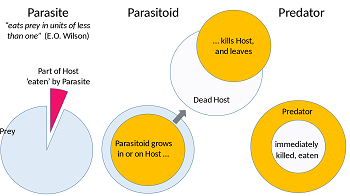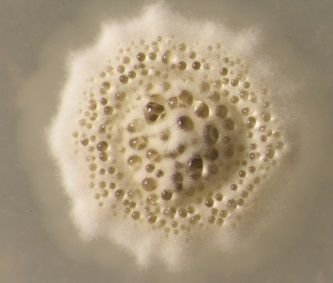
Good day everyone, thank you for reading the previous post on my blog. today I will be writing on the diverse and important ways of interaction between the microbial population and it's physical environment.
Microorganisms do not exist in isolation, they interact and live together with other living organisms. Microbial interactions could have a positive, a negative or neutral impact on the species involved. It is important to discuss this topic because microorganism play an important role in succession, or the predictable changes that occurs in the ecosytem when they are disturbed.
Microorganisms can physically interact with other organisms (Microbial Consortium) in many ways. An association of two or more different species of organisms is called symbiosis can be either Ectosymbiotic, a situation whereby an organism lives and survives on the surface of another organism or Endosymbiotic in this case the microorganism is located within another organism. There are also some situations or cases in which microorganism live on both the inside and outside of another organism, this phenomenon is called Endo/Ectosymbiosis.
Types of Symbiotic Interactions.
- Mutualism
- Parasitism
- Cooperation
- Predation
- Amensalism
- Commensalism
- Competition
Mutualism
An obligatory win-win(benefits both organisms) relationship between organisms that depend on each other for their metabolic requirements, these organisms do not survive separation in most cases. Microbial mutualistic association is a common phenomenum in insects, the marine invetebrates, and the rumen ecosystem.
Examples of Mutualism includes;
E.coli in thee large intestine synthesis Vitamin K and some B vitamins thet absorbed by the human host and distributed by body cells in exchange for the provision of nutrients for the survivial of E.coli.
Aphid and Buchnera aphidicola in its cytoplasm, whereby providing its host (Aphid) with the amino acid tryptophan and the organism (B. aphidicola) is also provided with its physical habitat and nutrients needed for its survival.
Wolbachia pipientis an endosymbiont of insect species which can control the reproduction of its hosts is found in about 20% of insects. It can cause parthenogenesis in butterflies and the feminization of genetic males in isopods. The benefit of this relationship to Wolbachia pipientis is that by creating an asexual environment is needed for its longer maintenance in the environment.
Cooperation
Cooperation is a positive (and not obligatory) symbiotic relationship where one organism lives off the byproducts of another, and both organisms benefits in the relationship, cooperation differs from mutualism because the relationship is cooperative and not obligatory. The word synergism best describes cooperation between microbial populations and the physical environment.
Examples of cooperation in microorganisms includes:
Cooperative relationship between marine free-living nematodes with bacteria whereby the worm uses the bacteria as a food source and the bacteria also protects the nematode by decreasing sulphide concentrations near the worm. The bacteria is also sulphide-oxidizing thereby providing nutrient for its growth and survival.
Pathogens that cause peridontal disease and gingivitis have been found to have receptors rather than for the teeth.
Parasitism
A co-existence between host and parasite where one organism gains (parasite) and the other is harmed (host) is called Parasitism. Successful parasites have evolved to co-exist with their hosts in equilibrium and if the balance is upset, the parasite or host may die.

Examples of Parasites includes:
- Coryneobacterium diphtheriae that produces toxins in its host
- Rhizoctonia solani which is a parasite of Mucor and Phytium, and is important in biocontrol processes.
- Fungi that are parasitic in nature includes Rhizophydium sphaerocarpum with alga spyrogyra
Predation
Predation among microbes involves a predator that attacks and engulfs its prey, the prey can be larger or smaller than the predator, usually killing the species preyed upon.

Examples of predation include:
Vampirococcus and it’s prey, where it attaches to the surface and secretes enzymes to release the cell contents of its prey.
Ciliates engulfs their prey (bacteria)in sewage and aquatic environments.
Some fungi can trap protozoa, for example Arthrobotrys traps nematodes by the use of constricting rings. Once trapped the hyphae grows into the prey and the cytoplasm is used as of source of nutrient.
Commensalism
In commensalistic relationships one organism benefits and the other is neither harmed nor helped (neutral effect). The growth and survivial of one organism depends on or is by nutrients or growth factors, provided by another organism in the same environment. In this situation the waste product of one could be the substrate for another.
Examples of Commensalism include:
Corynebacteria inhabits the surface of the eyeball and certain saprophytic Mycobacteria that inhabit the ear and external genitals. These organisms live on secretions and do not bring any benefit or harm to the host.
E.coli that lives in the human colon,that uses up the oxygen in this environment thereby creating an anaerobic environment for obligate anaerobes like Bacteroides to survive in the colon.
Ammensalism
Ammensalism is a unidirectional interaction based on the release of specific chemicals or compounds(bacteriocin, antibotics, dermicidin etc) that adversly affect another organism

Some examples include:
Antibiotic production by some microbes (bacteria and fungi) for example Streptomycete produces antibiotics that control the parasitic fungus Escovopsis.
Insects and mammals producing antibacterial peptides by e.g., cecropins, defensins, and athelicidins that plays an important role in innate immunity
Competition
Microbial competition occurs when two organisms try to use or colonize the same resource or nutrients. There is the intraspecific competition between organisms of the same population and interspecific competition within the organism of different species. competition can lead to a situation where one of the organisms involved outgrowth the other, if the said can produce harmful substances that affects the pH and Oxygen of the environment.
E.F Gause in 1934 executed a series of co-culture experiments and described the competitive exclusive principle. He observed that for some species pairs, when cultured together, one species (in this case, Paramecium aurelia)outgrown the other (in this case, Paramecium caudatum)but each species as an individual entity grew well in the absence of the other.
Possible outcomes of Competition
- The organisms involved could share the resource and both survive at a fewer population numbers.
- One organism dominates the other leading to the overlap in their resource use, and one population is excluded from the environment.
Examples of Competition include:
The normal microbiota of the adult human virgina maintains a pH of 3.5 to 4.5(an acidic environment) making it impossible for organisms such as Candida albicans(a pathogen) to survivial
Clostridium difficle releases toxins that induce diarrhea however the normal microbiota of the large intestine inhibits this bacterium by starving it of nutrients or by bacteriocin production.
Thank you for spending time to read, expecting your questions, votes and comments
References
Ref 1
Ref 2
Ref 3
Ref 4
Ref 5
Image Credit
Being A SteemStem Member